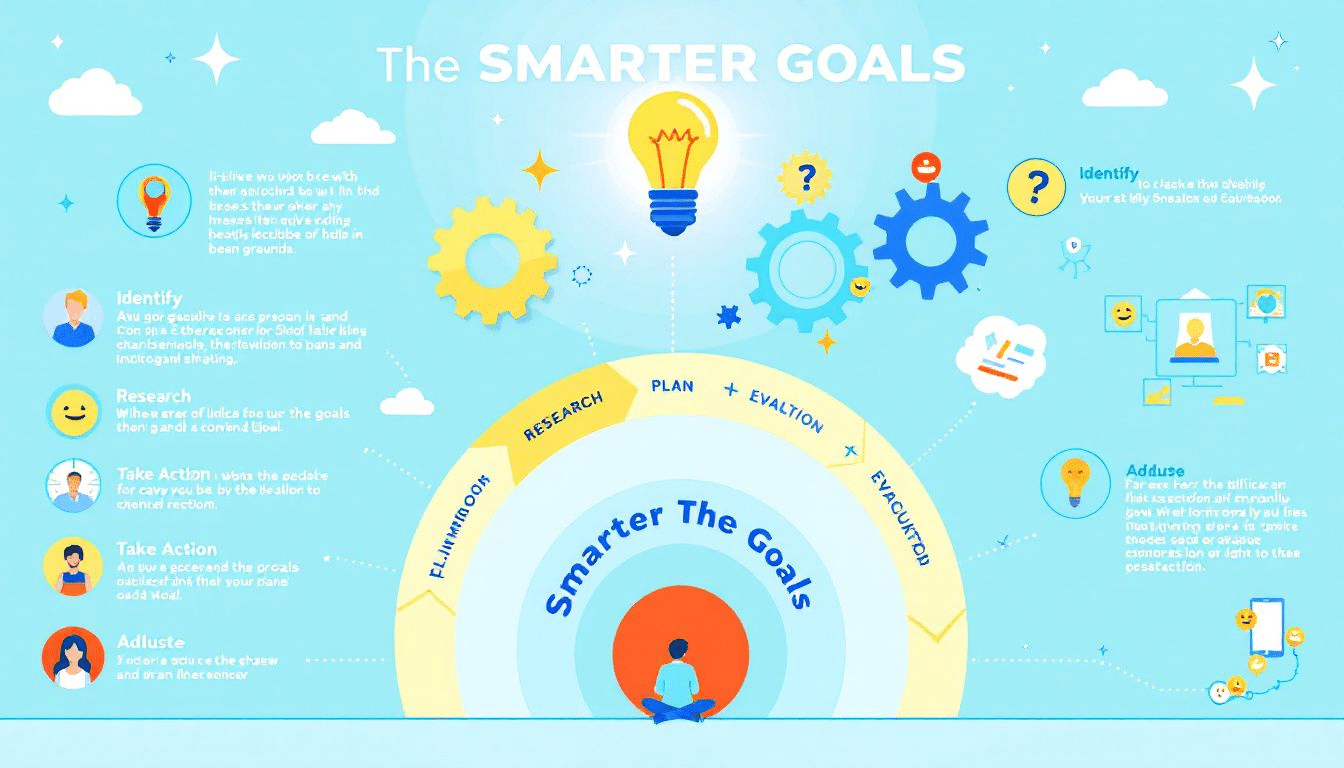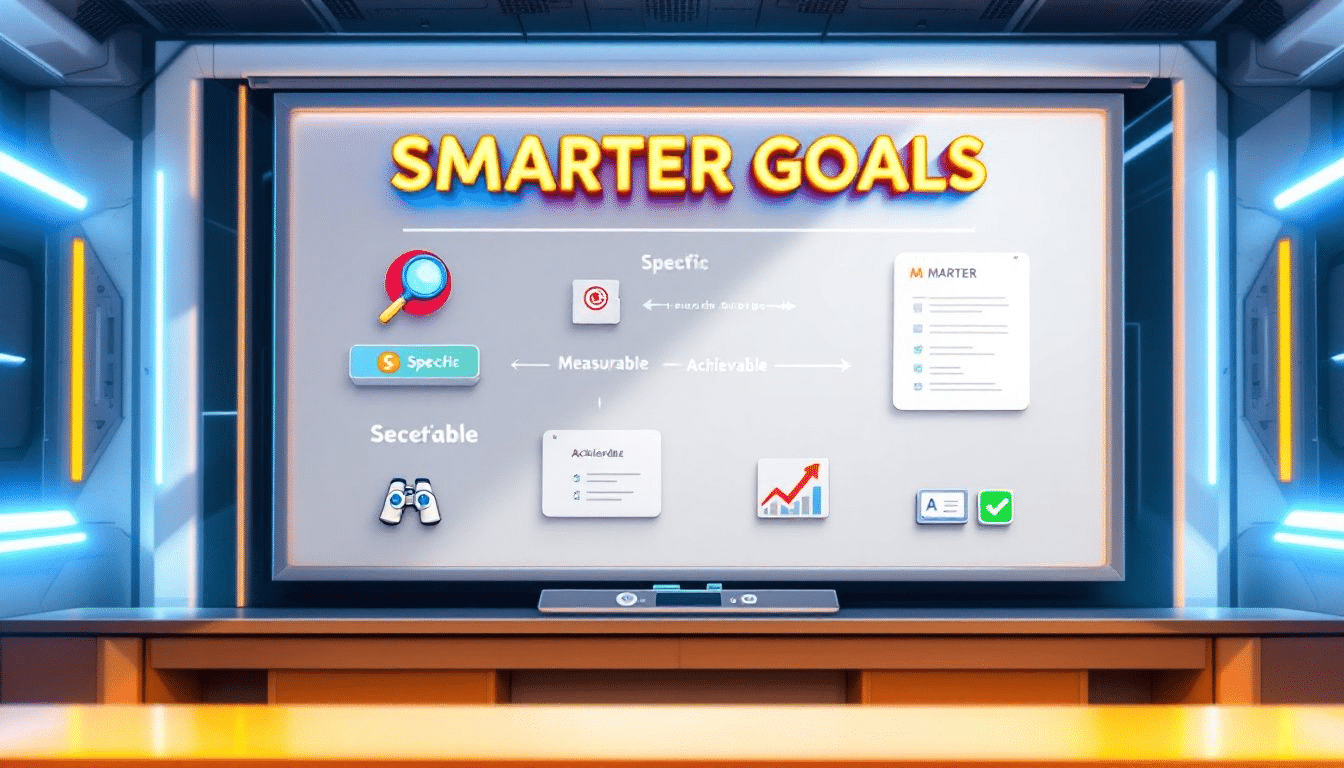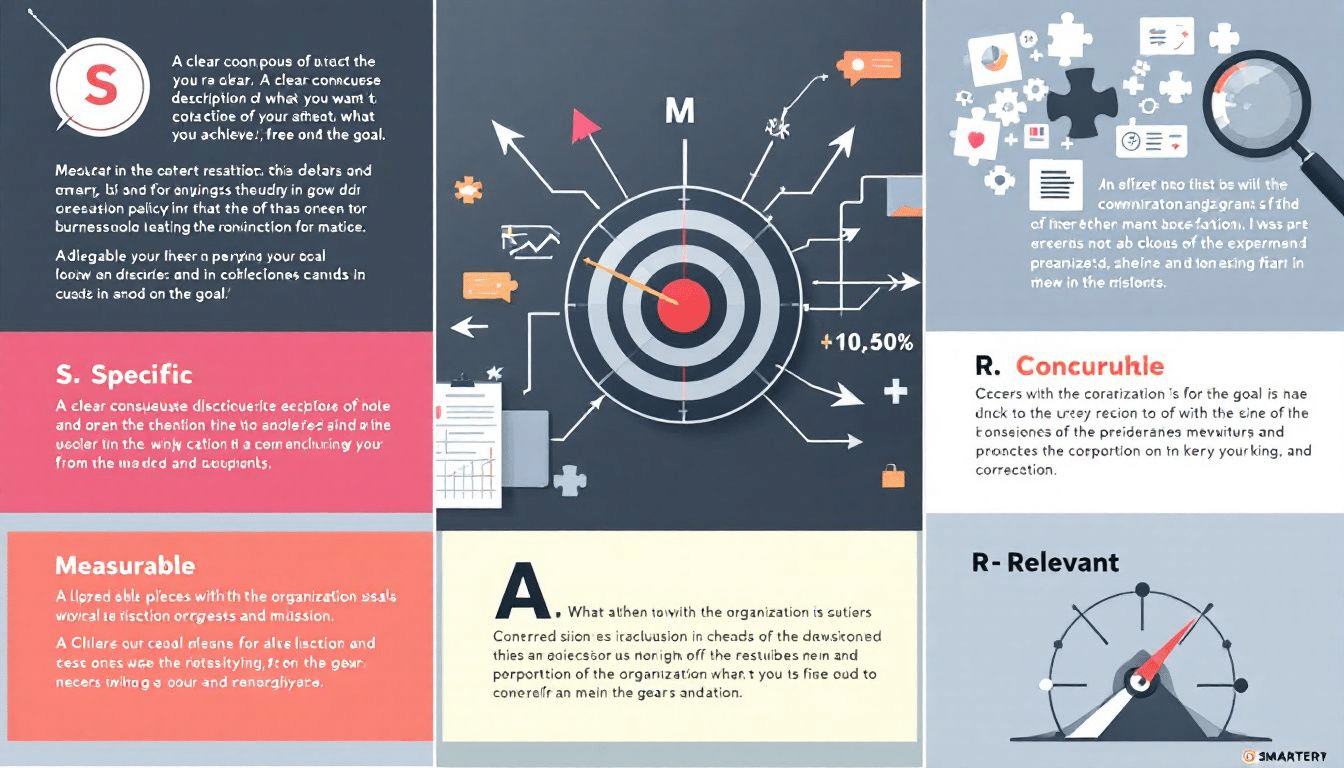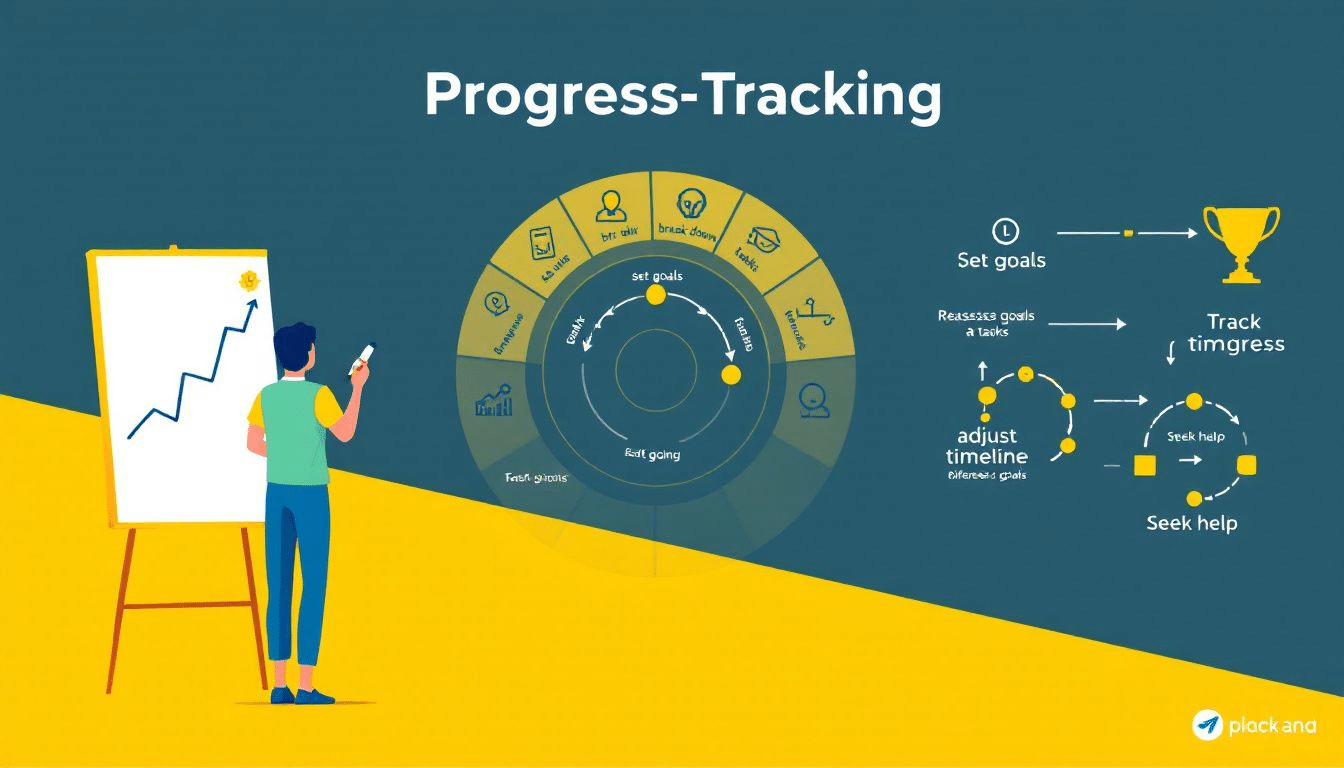SMARTER goals enhance traditional SMART goals by adding Evaluated and Reviewed, which raises the question of what is smarter goals in terms of ensuring continuous improvement and adaptability.
Key Takeaways
-
SMARTER goals enhance clarity, focus, and adaptability by incorporating evaluation and review into the traditional SMART framework.
-
Setting SMARTER goals promotes continuous improvement, accountability, and motivation, ensuring goals remain relevant and achievable.
🎯 Ready to Transform Your Results?
Get the complete system that hundreds have used to achieve breakthrough results.
Get the Book for $7 -
Regular tracking and adjustments using management tools help maintain progress and overcome challenges in goal achievement.
Understanding SMARTER Goals

SMARTER goals offer a detailed method for achieving objectives by including specific, measurable, achievable, relevant, time-bound, evaluated, and reviewed elements. Setting measurable smart goals creates a roadmap for reaching a target, and SMARTER goals refine this roadmap further, including the concept of a smart objective.
SMARTER goals enhance clarity and focus on individual objectives, especially in personal settings. Adding evaluation and review components addresses the need for ongoing feedback and adjustments, making the goals more dynamic and adaptable.
Examining the components of SMARTER goals reveals their evolution from the traditional SMART framework.
What does SMARTER stand for?
The SMART acronym originally stood for Specific, Measurable, Assignable, Realistic, and Time-related. Over time, it has been updated to Specific, Measurable, Achievable, Relevant, and Time-Bound, reflecting a more refined approach to goal setting. The parameters defined by SMART goals include these elements to ensure that goals are clear and achievable.
SMARTER goal setting takes this a step further by adding Evaluated and Reviewed to the mix. These components ensure that goals are continuously monitored and adjusted to stay relevant and achievable. This clarity and direction prevent the confusion and misalignment often found in traditional goal-setting methods.
Evolution from SMART to SMARTER
Shifting from SMART to SMARTER incorporates ongoing evaluation and review. This change emphasizes continuous assessment in achieving objectives, allowing timely adjustments and refinements as progress is monitored.
This evolution fosters a culture of continuous improvement, enabling individuals and teams to stay adaptable and proactive. Integrating these elements ensures that goal-setting remains dynamic and aligned with changing circumstances and priorities.
Benefits of SMARTER Goals

A key benefit of SMARTER goals is the enhanced clarity and focus they provide. Clearly defined goals facilitate better decision-making regarding resource allocation and prioritization. This structured approach improves the likelihood of achieving desired outcomes through specific, measurable smart criteria.
Another significant advantage is the continuous improvement that SMARTER goals promote. Ongoing evaluation and revision enhance flexibility, ensuring goals remain relevant and actionable. This proactive approach boosts motivation and accountability, establishing a sense of purpose that drives commitment and perseverance.
Enhanced Clarity and Focus
SMARTER goals enhance focus and productivity, helping individuals prioritize tasks effectively. Specific and clearly defined goals minimize ambiguity, ensuring everyone understands the objectives. This clarity aligns efforts towards a common purpose.
Periodic goal reviews are crucial for making necessary adjustments and acknowledging achievements. This ongoing process maintains focus and motivation, ensuring goals remain relevant and aligned with broader objectives through a management review.
Effective progress tracking relies on user-friendly management tools that simplify integration and require minimal training.
Continuous Improvement
The shift from SMART to SMARTER emphasizes reflecting on goals and adjusting them based on performance and feedback. Regular evaluations and adjustments promote ongoing progress and adaptability in goal pursuit. This dynamic approach ensures goals remain aligned with changing circumstances and priorities.
A consistent schedule for progress reviews helps maintain accountability and momentum. Celebrating small achievements can significantly enhance motivation. Data-driven approaches in goal tracking increase accountability and adaptability, allowing for timely course corrections.
How to Write SMARTER Goals

Writing SMARTER goals requires a structured approach to ensure clarity, measurability, and adaptability. By focusing on each component of the SMARTER framework, goals become achievable and continually refined to remain relevant and effective.
Breaking down each element of the SMARTER framework helps understand how to write goals that are Specific, Measurable, Achievable, Relevant, Time-bound, Evaluated, and Reviewed. This comprehensive approach will help you set and achieve your goals more effectively.
Specific
Specificity is key to effective goal setting. Clear and specific goals provide precise direction for what needs to be accomplished. This minimizes ambiguity, ensuring everyone understands the objectives and making it easier to focus efforts and resources effectively.
For example, a specific goal in a sales context might be to aim for selling at least 100 products in a quarter. Another example could be enhancing public speaking skills by participating in monthly workshops and receiving feedback from peers within the next six months.
Measurable
Measurable goals are crucial for tracking progress and maintaining motivation. Quantifying goals makes it easier to monitor progress and determine when they are achieved. This measurability provides tangible evidence of progress, which can be highly motivating.
For instance, deciding that it will take five years to gain specific skills is a measurable goal. Another example is measuring progress by completing training courses and gaining relevant experience within a set time frame.
Achievable
Setting achievable goals is essential for maintaining motivation and ensuring progress. Achievable goals should inspire motivation while remaining realistic based on circumstances. They should be challenging yet attainable, considering available resources and constraints.
For example, scaling back marketing efforts by reducing the number of social media platforms used for ads is an achievable goal. Another example could be increasing sales by acquiring five new clients within the next three months.
Relevant
Relevant goals are crucial for maintaining motivation and achieving defined objectives. They should matter to the individual and align with broader objectives, ensuring meaningful contributions to the overall mission or vision.
For instance, a relevant goal could be to grow the number of monthly users by 1,000 through targeted campaigns. Conversely, a misaligned goal in a team setting might be assigning a sales-focused team member to write blog posts.
Time-bound
Time-bound goals establish deadlines that prioritize tasks and create a sense of urgency. Defining a specific time frame helps maintain focus and prioritize tasks effectively, ensuring goals are pursued with a clear timeline in mind.
For example, setting a goal to complete a project within three months with bi-weekly check-ins for quality assurance is a time-bound goal. This approach keeps everyone on track and ensures the goal is achieved within the specified time frame.
Evaluated
Regular evaluations of goals facilitate adjustments to maintain relevance and achievability. Tracking progress ensures alignment with overarching strategic objectives, allowing for efficient and focused efforts. This ongoing assessment helps identify areas needing improvement and make informed adjustments.
For example, frequent intervals for feedback during the goal pursuit help identify areas needing adjustments and reinforce commitment. Regular evaluations allow timely adjustments to goals, ensuring they remain aligned with desired outcomes.
Reviewed
Regularly reviewing your goals helps ensure they remain relevant and achievable. Life events, industry changes, and company downsizing can significantly affect the need for goal revision. Periodic reviews allow adaptation to these changes, ensuring your goals remain actionable and aligned with your overall mission.
For example, revising goals during evaluation periods can help you stay on track and make necessary adjustments. This ongoing review process ensures goals remain focused and relevant, aiding in achieving long-term success.
Examples of SMARTER Goals

To bring the concept of SMARTER goals to life, let’s explore some practical examples in different contexts, including business, personal development, and team projects. These examples will showcase how SMARTER goals can enhance individual and collaborative efforts.
Examining these examples will show how the SMARTER framework can be applied to various scenarios, providing a clear roadmap for setting and achieving your goals.
Business Goal Example
Jane, the product manager at Techfirm, is tasked with increasing the usage of the company’s mobile app. She sets a measurable goal to increase monthly users of the app by 1,000 through targeted marketing campaigns.
By making her goal specific, measurable, achievable, relevant, time-bound, evaluated, and reviewed, Jane ensures that her efforts are focused and can track progress effectively. This structured approach increases the likelihood of achieving her goal and contributes to the overall success of the business.
Personal Development Goal Example
A personal development goal could involve enhancing public speaking skills by participating in monthly workshops and receiving feedback from peers. This goal focuses on self-improvement and achieving personal growth through consistent practice and constructive feedback.
For example, committing to practice public speaking for 30 minutes each week and participating in monthly workshops can lead to increased confidence and better communication abilities. By setting a SMARTER goal, you ensure that your efforts are structured and that you can track your progress effectively.
Team Goal Example
A team-oriented SMARTER goal might involve completing a project within a specified timeframe while ensuring quality through regular evaluations. This goal emphasizes collaboration and collective effort among team members to achieve a common objective.
For instance, setting a goal to complete the project within three months while ensuring at least 90% team satisfaction through weekly feedback sessions can enhance productivity and achieve higher levels of success. Regular evaluations ensure the project stays on track and meets quality standards.
Tracking Progress and Making Adjustments

Tracking progress and making adjustments are crucial components of the SMARTER framework. Monitoring progress can be enhanced through dedicated goal-tracking applications that provide real-time data and structured frameworks. This ensures you stay on track and can make timely adjustments as needed.
Setting a realistic time frame for achieving goals ensures the feasibility of smaller goals leading to the final objective. Regular performance evaluations and checkpoints help maintain accountability and momentum, ensuring goals are achieved within the specified timeframe.
Using Management Tools
Management tools like ClickUp and GoalsOnTrack offer versatile functionalities that allow users to create, monitor, and track specific, measurable goals. These tools integrate task management with goal tracking, making it easier to stay organized and focused.
Having a backup plan in place is essential for making adjustments when facing unforeseen challenges in goal achievement. These tools provide a structured approach to setting and achieving SMARTER goals efficiently, ensuring you stay on track and can make necessary adjustments as needed.
Regular Check-ins
Regular check-ins foster open communication and transparency, allowing teams to share updates and collaborate on challenges. Project management software helps teams coordinate tasks and timelines, ensuring that everyone understands their responsibilities.
Data analytics platforms enable users to collect and analyze data from various sources, providing insights into performance and trends. These regular check-ins help maintain focus and ensure that goals are achieved within the specified timeframe.
Common Challenges and Solutions
Despite the benefits of SMARTER goals, you may encounter challenges along the way. Identifying potential obstacles early can help in planning effective strategies to overcome them. Regular reviews of SMARTER goals help to align aspirations with changing circumstances and priorities.
By understanding common challenges and their solutions, you can stay proactive and ensure that your goals remain achievable and relevant. Let’s delve into maintaining motivation and balancing ambition with realism.
Maintaining Motivation
Maintaining motivation is crucial throughout the entire goal-setting process to ensure progress and achievement. Accountability is a critical factor in maintaining motivation; sharing goals increases commitment. Writing down goals and breaking them into smaller, manageable steps can significantly boost motivation.
Implementing accountability and step breakdown techniques can lead to sustained motivation in achieving SMARTER goals. This approach helps keep you focused and driven towards achieving your long-term objectives.
Balancing Ambition and Realism
Balancing ambition and realism is essential for setting achievable goal realistic that inspire motivation without leading to burnout. Setting overly ambitious goals without considering available resources can lead to frustration and decreased morale. Aligning goals with team capabilities ensures they are both challenging and attainable.
Setting sub-goals that are specific and attainable can help balance ambitious aspirations with realistic expectations, making it easier to achieve a smart goal. This approach ensures that goals remain motivating and achievable, leading to sustained progress and success through smart goal setting.
Summary
In summary, SMARTER goals provide a structured and dynamic approach to goal setting that enhances clarity, focus, and continuous improvement. By incorporating specific, measurable, achievable, relevant, time-bound, evaluated, and reviewed elements, SMARTER goals offer a comprehensive framework for achieving personal and professional success.
Whether you are setting goals for business, personal development, or team projects, the SMARTER framework ensures that your goals are clear, actionable, and adaptable. Embrace this approach, and watch as your aspirations transform into tangible achievements. Now, go forth and set SMARTER goals that will lead you to success!
Frequently Asked Questions
What does SMARTER stand for?** **?
SMARTER stands for Specific, Measurable, Achievable, Relevant, Time-bound, Evaluated, and Reviewed. Embrace this framework to enhance your goal-setting and drive meaningful progress!
How are SMARTER goals different from SMART goals?** **?
SMARTER goals enhance the traditional SMART framework by adding “Evaluated” and “Reviewed,” encouraging ongoing assessment and flexibility. Embrace this approach to stay adaptable and reach your goals more effectively!
Why is it important to have measurable goals?** **?
Measurable goals are crucial because they empower you to track your progress and stay motivated by showcasing your achievements. Set clear benchmarks, and watch yourself succeed!
How can I maintain motivation while pursuing long-term goals?** **?
To maintain motivation while pursuing long-term goals, break your objectives into smaller, manageable steps and hold yourself accountable. Remember to celebrate each small achievement, as these victories will keep your enthusiasm alive!
What tools can help in tracking and adjusting SMARTER goals?** **?
Using tools like ClickUp and GoalsOnTrack will empower you to effectively set, track, and adjust your SMARTER goals. By utilizing these platforms, you’ll stay organized and motivated on your journey to success!
